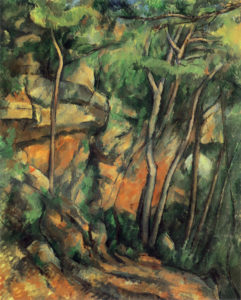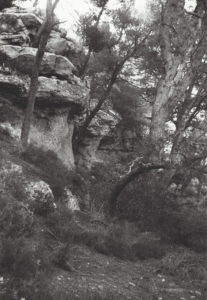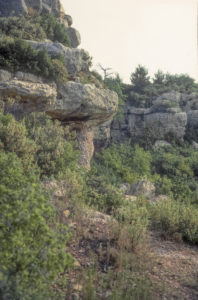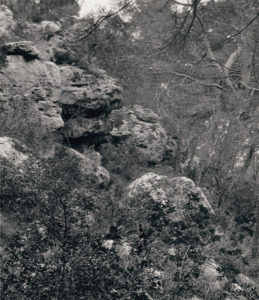R878 – Dans le parc du Château Noir, vers 1898 (FWN319)
Pavel Machotka
(Cliquer sur les images pour les agrandir)
The Bibémus quarry is a high, stone plateau; at its edge on one side the ground slopes down sharply and defines the Château Noir property. At their juncture, at the edge of the quarry, is an exposed layer of rock bordered by a path at its base. Standing on the path, which in the painter’s time was shaded by dense growth, Cézanne painted Dans le parc du Château Noir, in which the rocky ridge –bleached at the top by the sun — glows with an incandescent coral color. Only a short distance away, he painted the same view again (Arbres et rochers dans le parc du Château Noir,R908-FWN337) and then another view, further down (R909-FWN338).
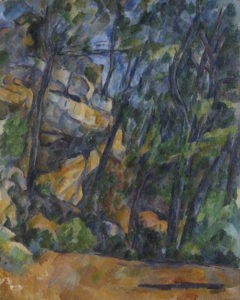
Arbres et rochers dans le parc du Château Noir, vers 1904
92 x 73 cm
R908 FWN337
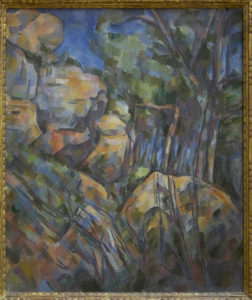
Rochers près des grottes au-dessus du Château Noir , vers 1904
65 x 54 cm
R909 FWN338
In the present painting, roughly contemporary with the preceding two, what strikes one first is the seemingly chaotic composition and the warm, filtered light. The composition is heavy on the left, inclined to the right, and dense, while the illumination is diffuse, almost mystical. The space is not frontal but twisting and sharply recessive; the prevalent rightward lean is allowed free play without the discipline of counterbalance. Providing relief from the red-green are only small glimpses of the sky at the top and a white rock; otherwise the cliff, rather than being restored to the more usual balance by grey-blues or grey-violets, is warm to the point of sultriness. The strength of the painting resides in the extremes to which Cézanne has pushed the color and in the evocation of a mood — through denseness, accidents of growth and erosion, and the suggestion of light without source and space without extension.
The motif has changed considerably. Rewald’s photograph shows the site shaded, the stones intact, and the saplings grown, while mine shows what red is left in the rock surface after the trees had burned down, and together they point to a curious literalness in Cézanne’s rendering of his motif. Neither in this painting nor in the previous two have we seen any of the abstract patches of the Northern Le Lac d’Annecy or Rochers à Fontainebleau; Cézanne here seems more closely attached to the accidents of his site. It is quite possible, as I have argued elsewhere[1], that it was his greater attachment to the landscapes of the South that delayed the development of the late, abstract patches.
Source: Machotka, Cézanne: Landscape into Art.
[1] In „From the landscapes of northern France to the beginnings of Cubism”, 2011.

